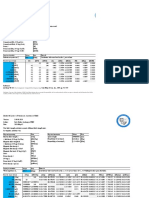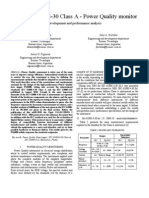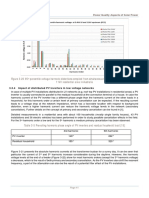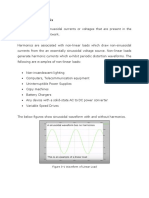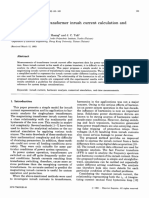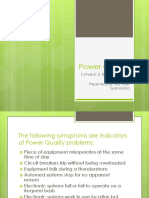0 ratings0% found this document useful (0 votes)
318 viewsIec 1000 3 7
BSI - BS IEC 1000-3-7 - Electromagnetic compatibility (EMC ...
Uploaded by
joiaros7Copyright
© © All Rights Reserved
We take content rights seriously. If you suspect this is your content, claim it here.
Available Formats
Download as PDF or read online on Scribd
0 ratings0% found this document useful (0 votes)
318 viewsIec 1000 3 7
BSI - BS IEC 1000-3-7 - Electromagnetic compatibility (EMC ...
Uploaded by
joiaros7Copyright
© © All Rights Reserved
We take content rights seriously. If you suspect this is your content, claim it here.
Available Formats
Download as PDF or read online on Scribd
You are on page 1/ 40
RAPPORT CEl
TECHNIQUE IEC
TECHNICAL 1000-3-7
REPORT Premio élton
First edition
1996-10,
Compatibilité électromagnétique (CEM) —
Partie 3:
Limites — Ei
Section 7: Evaluation des limites d’émission
des charges fluctuantes sur les réseaux MT et HT —
Publication fondamentale en CEM
Electromagnetic compatibility (EMC) —
Part 3:
Limits —
Section 7: Assessment of emission limits
for fluctuating loads in MV and HV
power systems —
Basic EMC publication
Numéro de référence
Reference number
CEWEC 1000-2-7: 1998,1000-3-7 © IEO:1996 -3-
CONTENTS
Page
FOREWORD, 5
INTRODUCTION :
Clouse
1 Scope.. 1"
2 Reference documents... "
3. Basic COnCEpIS sneer 13
4. General principles . sevnntnnnnininninisnnnannncsnnes 9
5. General guidelines for the assessment of emission levels 25
6 Summation effects ses 7 27
7 Emission limits for fluctuating loads in MV systems 29
7.1. Stage 1: simplified evaluation of disturbance emission. : 29
7.2 Stage 2: emission limits proportional to the agreed power of the consumer. . 31
7.8 Stage 3: acceptance of higher emission levels on an exceptional and
precarious basis i i : 37
8 Emission timits for fluctuating loads in HV systems : 37
8.1 Stage 1: simplified evaluation of disturbance emission 37
8.2 Stage 2: emission limits proportional to the agreed power of the consumet..wnn. 37
8.3 Stage 3: acceptance of higher emission levels on an exceptional and
precarious basis pevnesannnnvens
8 Emission limits for rapid voltage changes.
Annexes
A Simpl
B Addition of Pg from different busbars.. oe
C Examples of some typical case studies
xd prediction methods for flicker severity.
D List of principal letter symbols, subscripts and symbols... sees 7S
E Bibliography, esse ss . at1000-3-7 © IEC:1996
INTERNATIONAL ELECTROTECHNICAL COMMISSION
ELECTROMAGNETIC COMPATIBILITY (EMC) ~
Part 3: Limits —
Section 7: Assessment of emission limits for fluctuating loads
in MV and HV power systems —
Basic EMC publication
FOREWORD
‘The {EC (Intemational Electrotechnical Commission) is 2 worldwide organization for standardization comprising
all national electrotechnical committees (IEC National Committeas). The object of the IEC is to. promote.
national eooperation on all questions conceming standardization in the electrical and electronic Nelde, To
fend and in addition to other activities, the 10 publishes International Standards. Their preperation te
fed in the subject dealt with may
Participate in thie preparatory work. IMernational, governmental and non-governmental organizations liaising
With the IEC also participate in this preparation. The IEC collaborates closely with the international
Standardization Organization (180) in accordance with conditions determined by agreement betwoen the two
organizations.
2) The format decisions or agroements of the IEC on technical matters express, as nearly ae possible an
Intemational consensus of opinion on the relevant subjects since each technical committes has representation
from ail intorested National Comiittees.
8) The documents produced have the form of recommendations for international use and are published inthe form
of standards, technical reports or guides and they are accepted by the Nalional Committees in that sense.
4) In order to promote international unifieation, IEC National Committees undertake to appl
Standards transparently to the maximum extent possibie in. tneir ratio:
divergence betwa
Ingieated inthe Tater.
IEC International
and regionel standards. Any
the {EC Standard and the corresponding national or regional slandard shalt be clearly
5) The IEC provides no marking procedure to indicate iis approval end cannot be rendered responeibie for any
equipment declared to bs In conformity with one ofits siandards,
The main task of IEC technical committees is to prepare International Standards, In
exceptional circumstances, a technical commitiee may propose the publication of a technical
report of one of the following types:
+ type 1, when the required support cannot be obtained for the publication of an
International Standard, despite repeated efforts;
‘+ type 2, when the subject is still under technical development or where for any other
reason there is the future but not immediate possibility of an agreement on an
International Standard;
‘+ type 3, when a technical committee has collected data of a different kind from that which
is normally published as an International Standard, far example “state of the art”
Technical reports of types 1 and 2 are subject to review within three years of publication to
decide whether they can be transformed into International Standards. Technical reports of type
3 do not necessarily have to be reviewed until the data they provide are considered to be no
longer valid or useful.1000-3-7 © IEC:1996
IEC 1000-3-7, which is a technical report of type 3, has been prepared by sub-committee 77A
Low frequency phenomena, of IEC technical committee 77: Electromagnetic compatibility.
‘The text of this technical report is based on the following documents
Comimitee dat Report on voting
TINSEICOV TTNTBAIROV
Full information on the voting for the approval of this technical report can be found in the report
on voting indicated in the above table.
This report is a technical raport of type 3 and is of a purely informative nature. It is not to be
regarded as an Intemational Standard.Goneral considerations (introduction, fundamental principles)
_ Definitions, terminology
1 2: Environment
_Deseriation of the environment
Classification of the environment
Emission limits
Immunity limits (in so far as they do not fall under the responsibilty of product committees)
Installation guidelines
igation methods and devices1000-3-7 © IEC:1996 -11-
ELECTROMAGNETIC COMPATIBILITY (EMC) —
Part 3: Limits —
Section 7: Assessment of emission limits for fluctuating loads
in MV and HV power systems —
Basic EMC publication
1 Scope
This technical report outlines principles which are intended to be used as the basis for
determining the requirements for connecting large fluctuating loads (producing flicker) to public
power systems. The primary objective is to provide guidance for engineering practices which
will ensure adequate service quality for all connected consumers.
Since the guidelines outlined in this report are necessarily based on certain simplifying
assumptions, there is no guarantee that this approach will always provide the optimum solution
for all flicker problems. The recommended approach should be used with flexibility and
judgment as far as engineering is concerned, when applying the given assessment procedures
in full or in part
The final decision regarding the connection of fluctuating installations will always rest with the
utility
Problems related to voltage fluctuations fall into two basic categories:
— flicker effect from light sources;
— risk of the voltage magnitude being outside accepted tolerances.
This report primarily focuses on controlling or limiting flicker, but @ clause is included to
address voltage magnitude changes and their effects.
NoTes
1 This report uses the fotlowing torms for system voltage:
low voltage (LV) refers to Uy ths
medium voliage (MV) refers to 1kV< Uy S 5 RV:
high voltage (HV) refers to BSkV< Uy $250KV;
extra high voltage (EHV) refers to 280kV< Uy.
{In the contoxt ofthis report, the function of the network Is more important than its rated voltage. For example, &
HV system used for distribution may be given a “planning level” (see clause 3) whichis situated between these
of MV and HV systems.
2. The "oad" Is to be understood as the complate consumer's load.
2 Reference documents
IEC 50(161): 1990, Intemational Electrotechnical Vocabulary (IEV) - Chapter 161:
Electromagnetic compatibility
IEC 868: 1986, Flickermeter - Functional and design specifications
IEC 1000-3-3: 1994, Electromagnetic compatibility (EMC) — Part 3: Limits - Section 3:
Limitation of voltage fluctuations and flicker in low-voltage supply systems for equipment with
rated currents 16.41000-3-7 © 1EC:1998 -13-
IEC 1000-3-8: 1994, Electromagnetic compatibility (EMC) — Part 3: Limits - Section 5:
Limitation of voltage fluctuations and flicker in low-voltage power supply systems for equipment
with rated current greater than 16 A
3 Basic concepts
The international fickermeter (see IEC 868) provides two quantities to characterize the flicker
severity: Ps: ('st" referring to “short term’: one value is obtained for each 10 min period) and Pir
(Cif referring to “long term": one value is obtained for each 2 h period). The flicker related
voltage quality criteria are generally expressed in terms of Ps, and/or Pj, Pi, being derived from
groups of 12 consecutive Py, values:
z
Les? a)
Flicker measurements are generally made at the point of common coupling (PCO) of a
fluctuating load, i.e. at the MV or HV level in the context of this report. However, it should be
remembered that the background for limits is the possible annoyance of LV consumers. It is
assumed that the flickermeter is adapted to the voltage of the lamps so that the same limits
apply irrespective of the voltage of the LV distribution system. This is important because 120 V
lamps are less sensitive to voltage fluctuations than 230 V lamps and 100 V lamps are even
less sensitive (see figure 4).
Emission limits for individual equipment or a consumer's total load should be developed on the
basis of voltage quality criteria. Some basic concepts are used to evaluate voltage quality. In
order for these concepts to be useful in meaningful evaluation, they are defined in terms of
where they apply (locations), and how they are measured (measurement duration, sample
times, averaging durations, statistics), and calculated. These concepts are described here and
illustrated in figures 1 and 2. Definitions may be found in IEC 50(161).
Compatibility levels
These are reference values (see table 1) for coordinating the emission and immunity of
equipment which is part of, or supplied by, a supply network in order to ensure the EMC in the
whole system (including network and connected equipment). Compatibility levels are generally
based on the €5 % probability levels of entire systems using distributions which represent both
time and space variations of disturbances. There is allowance for the fact that a utility cannot
control all points of a network at all times. Therefore, evaluation with respect to compatibility
levels shauld be made on a system basis and no assessment method is provided for evaluation
at a specific location.1000-3-7 @ IEC:1996 ~15-
‘The compatibility levels for flicker in LV and MV systems are given in table 1
Table 1 - Compatibility levels for Ps, and Py,
in LV and MV power systems
Compatiity levals
P, 10
Py 08
Planning levels
These are levels that can be used for planning purposes in evaluating the impact on the supply
system of all consumers loads. Planning levels are specified by the supply utiity for all voltage
levels of the system and can be considered as internal quality objectives. Planning levels are
equal to or lower than compatiblity levels. Only indicative values may be given because
planning levels will differ from case to case, depending on network ‘structure and
circumstances. As an example, see the planning levels for Psy and Py, presented in table 2
Table 2 — Indicative values of planning levels for Po: and Pu
in IV, HV and EHV power systems
Planning levels
ww | AVERY
Pa | 08 08
Py_| 07. 06:
NOTES
4. These values were chosen on the assumption that the transfer cootliciont between MV or HV systems and
LV systems Is unity
2 In practice, transter costticients trom HV to LV (Tosa) ate often significantly lower than unity. A typical
‘value for Tray if 0,8 in such a case, the indicative planning level for HV becomes Lpyiy © 0,810.8 = 1.0.
3 The planning levels in table 2 are not Intended to control ficker arlsing from uncantrolable events such as
fauts in the power system, etc.
The rest of this report outlines procedures for using these planning levels to evaluate
connection requirements for individual consumers.
Assessment procedure
Measurements should be carried out according to EC 868 with a minimum duration of one
week. From the Ps; values measured during the observation week, the Cumulative Probability
Functions (CPF) of Pst and Py should be obtained and the percentiles Patasrs, Petao%: Prost
and Piao, should be derived:
= Pa1age should not exceed the planning levels;
= Piog% should not exceed the planning levels.
Notes
4 Comparing 99 % to 95 % pereenties may be useful. the ratio between them is greater than 1,9 one should
investigate the reason for ihe discrepancy. Possible abnormal results (e.g. due to thunderstorms) should then
be eliminated,
‘5 It ls worth noting that, with reference to an observation period of one week, the percentile Pago is excoeded
fora tatal ime of 1'h and 40 min, Theoretically, a luctuating ‘oad could generate severe flicker continuously for
Such a period and cause complains. Experianice has shown that load cycles of similar duration occur many
times ina week and uncommon load cycles (lor example amusement places, elc.) that might take place once a
week, usually last for more than 1,5 h to 2h.4000-3-7 © 1EC:1998 -17-
Figures 1 and 2 illustrate the basic concepts described above. They are
the most important relationships between the basic variables,
jended to emphasize
cae
—
Pasig |
ee? |e
fe
Probaty /\
iy iN
pment
Daur
Figure 1 - illustration of basic voltage quality concepts with
time/location statistics covering the whole system
cept r
ang
be
pease
y
Prcaiy
eats
Deuinaes ioe!
Figure 2 ~ Illustration of basic voltage quality concepts with
time statistics relevant to one site within the whole system
In the whole power system (see figure 1), interference inevitably accurs on some occasions
and therefore there Is significant overlapping between the distributions of disturbance and
immunity levels. Planning levels are generally equal to or lower than the compatibility ievel;
they are specified by the owner of the network, Immunity test levels are specified by relevant
standards or agreed upon between manufacturers and users.
At most locations in the power system (figure 2 is just an example), there is no overlap or only
a small overlap of disturbance and immunity level distributions; interference is therefore minor
and equipment functions satisfactorily
Emission levels
‘The emission level from a fluctuating load is the flicker level which would be produced in the
power system if no other fluctuating load was present. In order to compare the consumer's total
foad flicker emission with the emission limits, the minimum measurement period should be one
week. From the Py, values measured during the observation period, the Cumulative Probability
Functions (CPF) of Py, and Py; should be obtained and the percentiles Paisaxi and Pirsasut
should be derived:
~ Patgsx should not exceed the emission limit Epgut
~ Pigor Should not exceed the emission limit Eon,1000-3-7 © IEC:1996 -19-,
In practice, these emission levels are generally assessed from the available data concerning
the load and the system: their direct measurement is hawever possible.
In the case of a low background disturbance (Pat $ 0,5) the flicker level at the PCC should be
measured for the following two conditions:
= with the fluctuating load of the consumer connected;
— with the fluctuating load and any compensating equipment of the consumer
disconnected,
‘The second flicker value should be subtracted from the first one using the cubic summation law
(see clause 6). This method gives the conventional flicker emission of the user:
When the existing Py level at the POC is higher than 0,5, @ more refined method should be
used, as ihe previous method can lead to gross errors. For example, the net flicker emission of
the user can be evaluated by simulating the injection of the consumer's load current into a
model of the supply system. Several other methods are possible. Another technical report on
this subject is under consideration.
4 General principles
The proposed approach for evaluating the acceptability of fluctuating loads depends on the
agreed power of the consumer, the power of the flicker-generating equipment, and the system
characteristics. The objective i to limit the injection from the total load of ingividual consumers
to levels that will not result in flicker levels that exceed the planning levels. Three stages of
evaluation are defined, which may be used in sequence or independently.
Stage 1: simplified evaluation of disturbance emission
It is generally acceptable for consumers to install small appliances without specific evaluation
of flicker emission by the supply company. Manufacturers of such appliances are generally
responsible for limiting the emissions. For instance, IEC 1000-3-3 is a product family standard
Which defines emission limits of flicker for equipment connected to LV systems. There are
currently no emission standards for MV equipment for the following reasons:
= medium voltage varies between 1 KV and 36 kV;
— no reference impedance has been internationally defined for medium-valtage systems.
Even without a reference impedance, it is possible to define criteria for quasi-automatic
acceptance of consumers on the MV system (and even HV system). If the total fluctuating load,
or the consumer's agreed power, Is small relative to the short-circuit capacity at the PCC, it
should not be necessary to carry out detailed evaluation,
In clause 6, spenific criteria are developed for applying stage 1 evaluation,t
2
1000-8-7 © 1EC:1996 -21-
Stage 2: emission limits proportional to the agreed power of the consumer
If @ load does not meet stage 1 criteria, the specific characteristics of the flicker generating
equipment should be evaluated along’ with the absorption capacity of the system. The
absorption capacity of the system Is derived from the planning levels and is apportioned to
individual consumers according to their demand with respect to the total system capacity. At
medium voltage, the disturbance level derived from higher voltage systems should also be
considered when apportioning the planning levels to individual consumers.
The principle of this approach is that, if the system is fully loaded and all consumers are
injecting up to their individual limits, the tolal disturbance levels will be equal to the planning
levels. A procedure for apportioning the planning levels to individual consumers is outlined in
clause 7,
Stage 3: acceptance of higher emission levels on an exceptional and precarious basis
Under special circumstances, a consumer may require to emit more disturbances beyond the
basic limits (stage 2) allowed. The parties concerned, |.e. consumer and utility may agree on.
the connection with special conditions and a careful study of the actual and future system
characteristics has to be carried out in order to determine these special conditions.
NOTE - Emission limits obtained trom the application of the methads recommended in clauses 6 and 7 are
intended to keep flicker levels below the planning lavals. The appilcation of other methods recommended in
Clause 8 is intended to imit the magnitude of rapid voltage change.
Responsibilities
The consumer is responsible for maintaining his emissions at the PCC below the limits
specified by the utility. The utility is responsible for the overall control of disturbance levels
under normal operating conditions in accordance with national requirements.
The utility has to provide network data for evaluation purposes. The evaluation procedure (see
figure 3) is designed in such a way that the flicker emissions from the consumers do not cause
the overall system flicker levels to exceed the planning and compatibility levels. However, there
is no guarantee that the recommended approach will always avoid exceeding the levels.
Finally, the utility and consumer should cooperate when necessary in the identification of the
optimum method to reduce emissions. The design and choice of method for such reduction are
the responsibilty of the consumer.1000-9-7 © IEC:1996 ~23-
Stage 2
Stage 3
utility Cooperation
cope ————
choose the planning levels o
Loa and Lop ae a
ees
‘Assess gobal allowable
1
‘asses share a
Jobal conriouio|
that can no used
‘by consumer" v
Ea Foe Yes,
Pa< Ere Ne
F< Eu
‘Assess expected
disturbance level
‘based on actual
conditions ane other]
cemsions, 2
‘Racepted wt ‘Dovelop method
speciied To redues eresions
oncitons to acceptable levels
Figure 3 ~ Diagram of evaluation procedure
Consumer
Power varations
A sand
frequency 1
contrbuion rom tceal— [{¢#——*
‘consumarsfoads Y
Gpqad Gre
Tastes expected
‘emission at PCO,
Pay and
including effect
cof possible mitigation36
e
le
in
's
4
at
1000--7 © IEC:1996 ~25~
5 General guidelines for the assessment of emission levels,
Prediction of flicker levels should relate to the worst case under normal operating conditions,
allowing for daily and seasonal production and load variations, for future additions or changes
planned for the network and for some planned outage conditions that may last for a long period
of time, More details on the assessment of the emission levels in the power supply of industrial
plants may be found in another IEC publication [1}"!
However, some simplified prediction methods for flicker severity are given in this report, see
annex A. They are based on the "P,i = 1 curve" (figure 4 and table 3), which is valid for regular
rectangular voltage changes and which has different characteristics according to the voltage of
the LV distribution system of interest [2]
0
au gy
UI |
a
‘cyt ~«O~SC«NOHD «$0000
Pecan’ votage changes per mina
NOTE = Two consecutive voltage changes (one positive and one negative) constitute one “cycle",|.e. two
voltage changes per second mesn a 1 Hz fluctuation
oa
Figure 4 ~ Pst = 1 curve for regular rectangular voltage changes
MC ratrar ee eee ea eee eae~27-
Table 3 ~ Pst = 1 for regular rectangular voltage changes
7 aun
(eo)
mvt _[70v [ov] toov
07 | 7.864 | 6,905 3.488)
oz | 454s | sso 5,889
o« | ass7 | az 4,596
os | ass | sara 4,095
oes | 2as¢ | 3.454 3781
1 2rea | 3.283 357
2 2am | 2,859 2,859
3 igs | 2.334 2,523
5 aes | 1.957 2s
7 nase | nat 1987
10 120, | 1,586 874
PA soz | 1212 1.397
33 0906) 1.077 1193
48 087 | 1032 a7
66 oe: | 0967 1.076
110 075 | 0.868 0,984
176 ose | 0.766 oat
273 056 | os7t 0.728
378 os | ott ose
420 048 | 0.576 0,628
505 oa | 0si7 075
82 037 | 0,461 0,523
796 ose | 0.409 0472
1020 oz7s | 0.97 oan
1085 ze | ose ove
1200 oz9 | 383 0,463
1390 oss | ose o.ss4
1620 o.aca | 0.881 0.701
2400 ost | a7 at
2875 sroa_| 1,002 11905,
6 Summation effects
‘A general combination relationship for short-term flicker severity caused by various loads has
been found in the following form, where Pgs; are the various individual levels of flicker severity
to be combined
Pa= YD Pa (2
Early studies showed thet the value of the coefficient m to use depends on the characteristics
of the main source of fluctuation and can be classified in five categories given below:
m = 4: used only for the summation of voltage changes due to arc furnaces specifically
run to avoid coincident melts;
— m =3: this is used for most types of voltage changes where the risk of coincident voltage
occurring is small. The vast majority of studies combining unrelated disturbances will fall
into this category and it should be used whenever there is doubt over the magnitude of the
risk of coincident voltage changes occurring;
— m=3,2: this choice matches the slope of the straight part of the Ps
= m=2: this is used where coincident stochastic noise is likely to occur, for example
coincident melts on are furnaces;
= m= 1: the resultant Pst will approach the value given by this coefficient when there is 2
very high occurrence of coincident voltage changes.
curve (see figure 4);ceI-1996,
wultats de
2K
at depuis
valement
1s Pat de.
®
(4)
alliée des
et 1000-35
rtinsteatour
‘ys utilsont
Unealre pour
ne de racine
mn pot lors
‘ong terme
cable lore 06
face tings
ve sonsiers,
run ete et la
1000--7 © IEC:1996, -29-
Recent studies have shown that the summation law which best fits measurement results
Gocends on the Py percentile which is used for the evaluation, In a two-are furnace case, for
Gxample, 2 study showed m= + for Patsox, m= 2 for Parra, m= 8 for Perso and m= 4 for
Paygoxy. The same case showed m= 3 for Pugos
In general, a value of m= (‘cubic summation law’) has been largely used for years. It has
boen found to give conservative results and is generally accepted. This value is used in this
report for Pg; a8 well as for Pi, summation’):
Pan Qdpat 6
ir “
7 Emission limits for fluctuating loads in MV systems
7.4. Stage 1: simplified evaluation of disturbance emission
in stage 1, the connection of small loads can be approved without detalled evaluation of the
‘emission characteristics or the supply system response,
NOTE ~ For LV equipment, ee IEC 1900-29 (input currant < T6A/shasa) oF IEG 1000:8-5 (input current >
6Aphase).
“ke the cuble summation iaw ig accopted. is often convenient to replace Py by the equivalent severity ingietor
Fane eee aap in order to simply the calouatons. Several counties systematically uae Ay instead o! Py
fav Buh Mra Ae ly Ths subatton gives a near reialionship forthe evaiuaion o he fla Giturbence Ay,
(onorated by multiple exer sources
A,
The,
Moreover, taking into account the fac hat the long-term flicker severity is eblained as a cube reat
re eats aN vafues eccuring outing the observation period, the long-term seventy can also bo
lequvelentiiceator Ay By placing:
anys Pip By Pay? (NB Ast
“The use ofthe eqivlontsoverty Inscators ths sinpiies sls the caleuaton a the long-term severity, which
Tie sot oe average ofthe shorter valves an th near summation also applies for the evaluation ot
then lor egutvrent very Ax caused by sever soures:
=i An
It should aleo be comembered that Ay isnot nearly related to 2 relative valtage change, as Py 8,20 that the
tselunses tthe two seventy indleatorsonangee according to he problem considered
‘Sgreesng ha compet ovels and the planning eves forme of Aye and Ay es:
‘Table 1"~ Compatibility levels for Ay and Ay In LV and MV power systems
Corpaly vale
Be 19
os
“Table 2'~Indieative value of planning lvele for Ay and A In MV, HV and EHV power systems
Pian ivele
iv | HVE
or a
3 a2
NOTE - These values were chosen withthe astumption thatthe transfer coelicient Baween MY respectively
HV on the one sige and LV on tne einer side fs about unity,2.OEI1996
variations
anet du
sliss—.ent
2 puissance
atlisateurs
lial obéit &
HMérées on
atténuation|
fiath . de
au flicker
sficient de
i 4000-3-7 © 1EC:1998 -31-
‘The connection of a fluctuating load may be accepted without further analysis if the power
variations AS are within the following limits at the PCC. Those limits depend on the number r of
voltage changes per minute (a voltage drop followed by a recovery means two voltage
changes):
Table 4 ~ Stage 1 limits for the relative power variations in
funetion of the number of variations per minute
7 we(a57
nin") cm
> 200 on
tases 200 oe
rato oa
NOTE ~The power variations 4S may be lower, equal of higher than the rated power S, of the considered
‘eaupment (2g ora motor, aesount should be taken othe apparent power a staring and it may be AS = 9-8 Sy)
7.2 Stage 2: emission limits proportional to the agreed power of the consumer
Stage 2 enables the sharing of the total allowed flicker emission between the users connected
i toa common supply system.
‘The propagation of flicker disturbances in a radial power system follows quite simple laws:
= The flicker values present at 2 given voltage level will be fully transferred to the parts of
the system at a jower voltage with some attenuation (transfer coefficient somewhat lower
than 1, e.g. 0,8).*)
= Due to the inctease of fault levels with that of voltages and to the low coincidence of
voltage changes, flicker contributions from lower to higher voltage systems can be
: considered practically negligible (transfer coefficient equal io 0)
1A tanater cooticlent of 0,8 for Py of Py valuas means 0,69 = 0.5 for Ay oF Ay values.@CEI1996
eri, ta
au MT. Le
de flicker
es charges
vrle niveau
coker sur le
at
6)
©)
Sun réseau
gal 4 0,8 et
ea ‘Les
flicker MT,
1308
6)
6)
vlan:
1000-3-7 © IEC:1996 -33-
7.2.1. Global emission to be shared between the consumers
Firstly an application of equation (8) or (4) is necessary to determine the global contribution
rom all the fluctuating loads which are fed by this MV system. The actual flicker level in a MV
‘system results from the combination of the flicker level coming from the upstream HV system
‘and of the flicker level resulting from all fluctuating loads connected to the MV system. This
‘actual flicker level should not exceed the planning level of the MV system
Calling:
Gesinty the maximum global contribution of the local loads to the flicker level in the MV
system (expressad in terms of Pa):
Lpsiuy the planning level of the flicker level in the MV system;
Lpstiy the planning level of the flicker level in the upstream HV system;
Tram the transfer coefficient from the upstream HV system to the MV system,
the application of equation (3) gives:")
Gosnay = YUbsoay ~ Tratan UPstay (6)
and similarly, from equation (4):
Thon LP )
Gena = Feta
For illustration purposes, equations (5) and (6) have been applied in the particular case of a
MV system, assuming that the transfer coefficient (Ty) fram the upstream HV system is equal
to 0,8 and assuming that the planning levels in the HV and MV systems are those of table 2.
The results are given in table 5.2)
Table 5- Example of acceptable global contribution of the MV loads to the MV
{licker levels if the transfer coefficient from the HV system is
supposed to be 0,8
Soa Sean
0,79 2.63
NOTE ~ Tyyy = 08 fr By oF Py is
usual older of magtude Tor
thie. transler coefficient, whilst
That usualy remains close to
unl CT = 0.5)
1) In toums of Aun Ay, the same equations are tne
Saaamy * Cray Thonn Laas 6
Gansoy® ann = Tain Se 6
2) in toims ofA, and A,, the corresponding transfer costficlent is THM = 0,5 and table 7.2 becomes:
“Table 5'- Example of aceepiable global contribution of the MV leads
to the MV Hiker level if tye transtor coefficient
fom tne HV system le supposed to be 0,5
a
80 025,7@ CEI1996
ef. ssion
Isateurs. On
souscrite S;
AMT, & la
ouscrite est
respondante
seeau n'est,
réseau de
instormateur
‘bution d'un
dun réseau
serturbations.
nent, de telle
ques de Fay
), les limites
”
(8)
pormale» étant
vr te niveau do
3 forme), faut
cndossus peut
ins tous les cos
Blea 6 donne
o
«
1000-3-7 © 1EC:1986 -35-
7.2.2 Individual emission limits
For each user in a given supply system, only @ part of the globally acceptable emission may be
allowed, due to the presence of other users. This share can be determined according to the
ratio between his agreed power §; (S| =P) /cos@)) and the total power of the loads directly
‘supplied at MV, al saturation of the system, Syy. This criterion has been chosen because the
agreed power is roprosentative of the usage of the supply and thus it is also related to a
corresponding share in the investment costs of the power system.
‘The ralationship between supply capacity and network equivalent impedance is not normally
‘constant when moving along the lines of a distribution system, whilst itis easily derived at the
busbars of a supply transformer, However, the S/Syy ratio appears to be an equitable criterion
to assign to each user an allowad share of licker emission,
According to this concept a user will be allowed to share not only the capacity of a network to
supply his loads, but also its capacity to accept the emission of disturbances up to the planning
level, and a coordination of emission will be possible.
Furthermore, all MV fluctuating loads may not be in simultaneous use, so that a coincidence
factor Fy ¢ 1 may be Introduced (typical values of Fy are 0,2 to 0,3).
Taking account of the recommended summation law (equations (3) and (4)) the individual
emission limits are then: 1)
st
Emet = Grav is Far ”
et
Epy = Goa & Far (8)
NoTes
1 Itimay happen thatthe background level (Beau) I8 higher than the normal share (the "normal charo" Boing
proportional to §{/Syy—5)/ Syy ) and should be taken ino account in order fo avsid exceeding the planning
level. in equation (6) (ar similarly in equation (6) for Song-arm Micker), Lpyygy iS then to be replaced by
las 2
2 For users having a comparatively low agreed power, the above approach may yield to sit limitations. To
‘vercame ths prblem it le propesed that eeriain minimum emission faves wil always be granted for short ane
Tong-erm Hicker seventies, These bsalevaluoe are shown In table 6°)
‘Table 6 ~ Basic omission lovels
Ea G
035 025
1 in torms of Ay and Ay, the equations become:
”
1
a a
Sw Faw us
2) or, mare simly. aun i oe rpi8c03 BY (Laan ~ Brau
5) ntems of Ayan Ay, thi ee becomes:
Eun = Gan
‘Table 6'~ Basle emission levels,
Ea 5,
0.05; 002ent
nce
ala
(9)
ans
ale
du
BT
ale
le
jon
tte:
lav
de
+4000-3-7 @1EC:1996 -37-
7.3. Stage 3: acceptance of higher emission levels on an exceptional and precarious basis
It should be noted that many consumers do not produce significant flicker, because they do not
have fluctuating loads of significant magnitude. Furthermore some of the available supply
capacity of the network may not be taken up for a very lang time.
‘As a result, a pure application of stages 1 and 2 can lead to undue limitation of flicker levels to
values which are below the planning levels, thereby creating a margin.
To preserve the general principles and allow flexible interpretation of this report, the utility may
use the available margin when appropriate. However, acceptance of higher than normal
emission limits may be given to consumers only in exceptional circumstances and on a
precarious basis.
Stage 8 is important in order to postpone investments which will perhaps never become
necessary. It means that a careful study of the connection should be carried out, taking
account of the existing’background flicker and of the expected contribution from the considered
‘equipment, and bearing in mind that arrangements will probably be necessary in order to make
an eventual future extension of the compensating installation possible.
8 Emission limits for fluctuating loads in HV systems
8.1. Stage 1: simplified evaluation of disturbance emission
The objective of stage 1 is to provide very simple decision criteria for the connection of
fluctuating loads, thereby avoiding detailed evalvation. For HV and EHV systems it is justified
to relate the maximum apparent power demand (Smax) of the fluctuating foad to the network
short-circuit power (S.q) at the PCC, For example,
‘Smax/Ss0 $0.1 % CO)
may be proposed as stage 1 limits.
8.2. Stage 2: emission limits proportional to the agreed power of the consumer
The approach is basically the same as for MV users (see 7.2). However, in the particular case
of HV users, the share of each one should be related to the total power available for all of them
and not to the total supply capacity of the system: it has been established that the contribution
to the HV flicker level coming from the MV and the LV systems can be neglected and theretore
their share of the total supply capacity is not to be taken into account.
8.2.1 Assessment of the total available power
Calling S; the MVA rating of installation i and Syjy the total power available for HV users at the
Point of common coupling, the S/Siy ratio is the basic quantity for the determination of the
‘emission limits following the stage 2 procedure,
First approximation
Assessing Syiy may be difficult. The suggested approach is the following: at a given HV
Substation, the basic information is an assessment of powers Sijy feeding HV users from the
substation during a maximum demand day (or forecasts taking account of the network
evolution in the future),CB
i
in ‘os
1
oF out
User User 2
(Sw) (Saw)
Suv = 2 Sav (10)
roximation
ple approach may nol be correct if important fluctuating installations are present or are
‘game in the vicinity of the considered substation. In case of doubt, it is recommended
ed as follows:
4 situ ling °1" the considered node and "2 etc. the other nodes located in the
ation ( iy of the first one, the values of Syivs. Swava, Svs. - - will be calculated according to
(ie (19).
@ tensi , power frequency, the influence coefficients Kp.1, Kg.1,. . . will be calculated (the
i dun nce coefficient K;, is the voltage which is caused at nodé i when a 1 p.u. (per unit)
lisée "ig injected at hode |; the calculation of K,, usually requires the use of a computer
am but annex 8 gives a simplified method which may be used in many cases for a
‘assesomont).
ion (10) will be replaced by:
Et
= Sav = Stayt + Ke-rStuve + Ko-rStava + -« (10)
»Styj terms as long as they remain significant as compared to Syav7 © OEI:1936
Jimites
ay
2)
est destings
ormalon stant
sgetorme}, faut
1s peut entsiner
es eas eertaine
sme ene valeurs
tue évalusnt es
‘ieoaux THTIMT,
vate
Ww réseau);
fond
ow
29
1000-3-7 6 1EC:1996 -41-
8.2.2 Individual emission limits
‘Faking account of the recommended summation law (equations (8) and (4)) the individual
mason is are then
Frat =Leaiy — an
Hv
Ena =Lrw $e (12)
on
vihere:
Ena isthe Pa: emission limit for user i
Leena the planning level in HV systems;
S.= Pi cosh, i the agreed power of user i
Suv is tho pat ofthe total supply capacity ofthe HV substation which s devoted
to the HV users.
Notes
1 tt may happen thet the background level (Gray) is higher than the normal share (the “normal share" being
proportional to @Sqy5)/ Sew Aa shoul! be taken info account In order to avold exceeding the planning
ave formula (11) (or similarly in formule (12) for long-term Hicker, Lesa 16 then to be replaced by
a
Wan ~ Be
2. For usors having a comparatively low agreed power, the above approach may yold {oo strict imitations. To
Svercome his problem i fe proposed that certain minimum emission levels wil stwaye be graniod for sner- and
fangcerm ficker severies, These basic values are shown In table 7)
‘Toble 7— Basle emission tevels
Ee Eon
08s 025
8. An alierative aparoach to the second approximation consists in carrying outa classical study evaluating he
filets of tne diferent fizetuatin loads taking into account the evolution of the EHVIHY syslem coniguration,
{ade datrbution and expected poreaniage of uctuating Yoads.
“The emission mite for EHVIMV ioads wil be defined bythe ulti ont
= adopted planning levels on EHVIHY systems (dep
= expected fluctuating proie
~ salty margin, it any
= national regulaions f any (particulery forthe conneetion of are twnacos),
basis of
nding on system peculiarities)
system, evaluated a5 above, Including background love!
on
2)
2) oF, mors simply, aay i610 be coplaced by (Laany ~ Bani:
9) in terms of Ay and Ay, this table becomes:
‘Table 7 — Basle emigslon tovole
Eat Ene
aes
tie
ue
es
ne
ce
‘is,
ux
ais
ant
du
afin
jon
urs
pur
ont
res
oir
13)
14)
4000-3-7 @1EC:1996 =43-
8.3. Stage 3: acceptance of higher emission levels on an exceptional and precarious basis
It should be noted that many consumers do not produce significant flicker, because'they do not
have fuctuating loads of significant magnitude. Furthermore, some of the available supply
Capacity of the network may not be taken up for a very long time.
‘As a result, a pure application of stages 1 and 2 can lead to undue limitation of flieker levels to
values which are below the planning levels, thereby creating a margin.
‘To preserve the general principles and allow flexible interpretation of this report, the ulility may
use the available margin when appropriate. However, acceptance of higher than normal
‘emission limits may be given to consumers only in exceptional circumstances and on a
precarious basis.
Stage 3 is important in order to postpone investments which will perhaps never become
necessary. It means that a careful study of the connection should be carried out, taking
account of the existing background flicker and of the expected contribution from the considered
equipment, and bearing in mind that arrangements will probably be necessary in order to make
an eventual future extension of the compensating installation possible
9. Emission limits for rapid voltage changes
NOTE - Picker limits should anyway be checked ist. This clause gives addtional requirements.
‘The visual discomfort due to light flicker is the most frequent reason to limit voltage changes
due to fluctuating loads. However, the ulities have to maintain the voltage magnitude within
narrow limits and individual consumers should not provoke too great voltage variations even if
they are tolerable from the flicker point of view,
Practically, the coincidence of occurrence of several rapid voltage changes presents a very low
probability. For this reason no summation laws are taken into account.
‘A simple assessment of the relative voltage change may be done as follows (see figures 5
and 6) [1]
Al= Aly ~ Al 3)
1 XL (14)
Figure Sa) ~ Equivatent circult Figure 50) Vector diagram
Figure 5 ~ Steady-state and dynai
voltage changes36
8)
6)
ce
la
ar
tre
1000-3-7 ©IEC:1996 ~45-
Figure 6 ~ Steady-state and dynamic voltage changes:
‘AU: Steady-state voltage change
AUgyn: Dynamic voltage change
For single-phase and symmetrical three-phase loads:
AU gyn = Alp “Ry + Aly XL, (15)
‘The emission limit at the PCC requires a limi
jon of AUgyn with respect to the actual voltage:
Up —AUg # AUgyn, (16)
Table 8 gives the maximum voltage change AUgyn/Uy for normal operating conditions
(expressed in per cent of the actual voltage) a consumer may cause, depending on the
repetition frequency of these changes. Less frequent voltage changes (e.g. less than one per
day) are not covered here; however, they may be of importance on some systems.
Table 8 ~ Emission limits for voltage changes in function
of the number of changes per hour
r BUaylU
(nour) cay
wr BT
ret 4 3
tersto | 8 25
10<7 100) 2 15:
yoo
You might also like
- IEEE Guide For Making Corona (Partial Discharge) Measurements On Electronics TransformersNo ratings yetIEEE Guide For Making Corona (Partial Discharge) Measurements On Electronics Transformers16 pages
- AZ125: Industrial Safety Starts With IEC/UL 60730 StandardsNo ratings yetAZ125: Industrial Safety Starts With IEC/UL 60730 Standards48 pages
- EMCview - Files - CISPR 14 - EN 55014 - V1 - 1No ratings yetEMCview - Files - CISPR 14 - EN 55014 - V1 - 118 pages
- Decibel Linear in Cable-Systems - Academy of EMCNo ratings yetDecibel Linear in Cable-Systems - Academy of EMC10 pages
- (IEEE) Trial Use Guide For Testing Permanent Magnet MachinesNo ratings yet(IEEE) Trial Use Guide For Testing Permanent Magnet Machines56 pages
- c37.90.2-1995 Capability Capability of Relay Systems To RadiNo ratings yetc37.90.2-1995 Capability Capability of Relay Systems To Radi14 pages
- PID3693797, Rightsizing Generators Through Harmonic MitigationNo ratings yetPID3693797, Rightsizing Generators Through Harmonic Mitigation9 pages
- Figure 3-20 95 Percentile Voltage Harmonic Distortions Compiled From Simultaneous Measurments at Both 0.4kV and 11kV Residential Area in AustraliaNo ratings yetFigure 3-20 95 Percentile Voltage Harmonic Distortions Compiled From Simultaneous Measurments at Both 0.4kV and 11kV Residential Area in Australia10 pages
- A Combination of Shunt Hybrid Power Filter and Thyristor-Controlled Reactor For Power QualityNo ratings yetA Combination of Shunt Hybrid Power Filter and Thyristor-Controlled Reactor For Power Quality17 pages
- (R2002 IEEE Standard Test Specification For Thyristor Diode Surge Protective DevicesNo ratings yet(R2002 IEEE Standard Test Specification For Thyristor Diode Surge Protective Devices56 pages
- IEC 479 1 1994 Effects of Current On Human BeingsNo ratings yetIEC 479 1 1994 Effects of Current On Human Beings70 pages
- ISIEC60269 Part6 2010 (Reaffirmed2024) Smgrexv20vcomu3voine2x22u0sd20241019121035No ratings yetISIEC60269 Part6 2010 (Reaffirmed2024) Smgrexv20vcomu3voine2x22u0sd2024101912103528 pages
- 1 Harmonic Analysis: Figure 3-1 Waveform of Linear LoadNo ratings yet1 Harmonic Analysis: Figure 3-1 Waveform of Linear Load12 pages
- Industrial Safety Starts With IEC UL 60730No ratings yetIndustrial Safety Starts With IEC UL 6073051 pages
- As 60470-2001 High-Voltage Alternating Current Contactors and Contactor-Based Motor-StartersNo ratings yetAs 60470-2001 High-Voltage Alternating Current Contactors and Contactor-Based Motor-Starters10 pages
- A Simple Model For Transformer Inrush Current Calculation and Harmonic AnalysisNo ratings yetA Simple Model For Transformer Inrush Current Calculation and Harmonic Analysis11 pages
- Electrical Power Systems Quality: Yiting Zhao Yitingzh@buffalo - Edu100% (1)Electrical Power Systems Quality: Yiting Zhao Yitingzh@buffalo - Edu32 pages
- IEEE 1547: The DG Interconnection Standard: The Regulatory Assistance ProjectNo ratings yetIEEE 1547: The DG Interconnection Standard: The Regulatory Assistance Project23 pages
- SunSpec Modbus IEEE 1547 2018 Profile Specification and Implementation Guide v1 0No ratings yetSunSpec Modbus IEEE 1547 2018 Profile Specification and Implementation Guide v1 035 pages
- Electromagnetic - Compatibility (Parts of IEC 61000 SERIES)No ratings yetElectromagnetic - Compatibility (Parts of IEC 61000 SERIES)5 pages
- 1.6 Standards and Guidelines Referring To Power QualityNo ratings yet1.6 Standards and Guidelines Referring To Power Quality2 pages
- Power Quality in European Electricity Supply Networks - 1 Edition Network of Experts For StandardisationNo ratings yetPower Quality in European Electricity Supply Networks - 1 Edition Network of Experts For Standardisation62 pages









